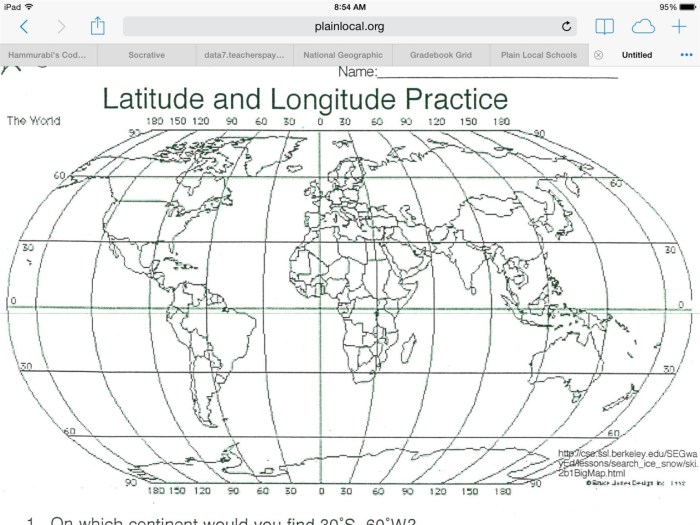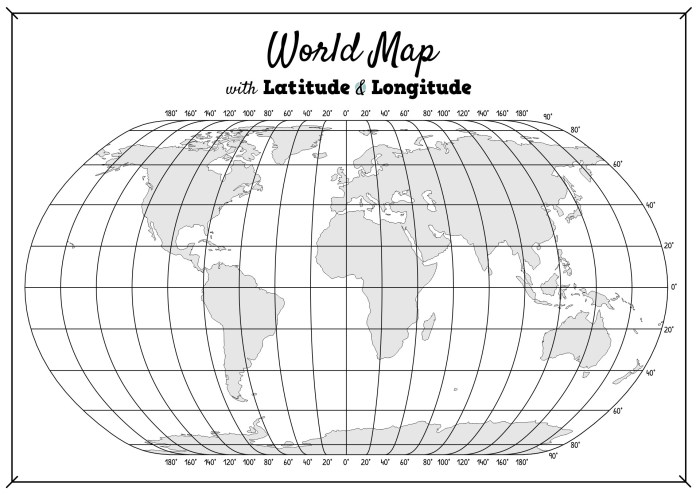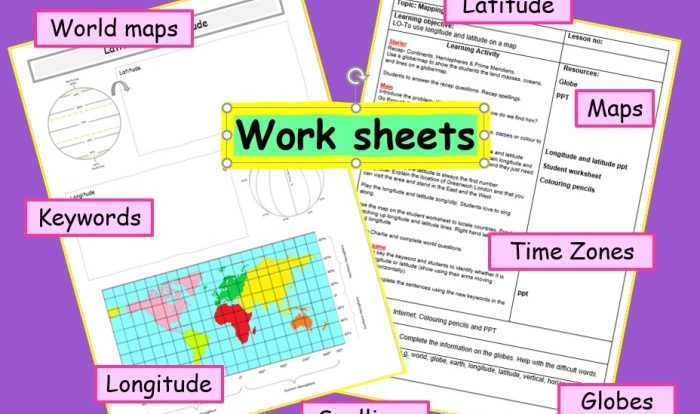Embark on a captivating journey into the world of coordinates with our Latitude and Longitude Practice Worksheet. This comprehensive resource empowers you to grasp the fundamentals, navigate real-world applications, and unravel the mysteries of our planet’s geography.
Delve into the concepts of latitude and longitude, understanding their significance in navigation, climate zones, and more. Discover the techniques for determining these coordinates using maps, GPS, and online tools, and explore their diverse applications in fields ranging from navigation to archaeology.
1. Defining Latitude and Longitude: Latitude And Longitude Practice Worksheet

Latitude and longitude are a system of geographic coordinates that define the location of any point on the Earth’s surface. Latitude measures the angular distance north or south of the equator, while longitude measures the angular distance east or west of the prime meridian.
These coordinates are essential for navigation, mapping, and various other applications. They provide a precise and standardized way to identify and locate places on the globe.
2. Understanding Latitude and Longitude Values
Latitude values range from 0° at the equator to 90° at the North and South Poles. Longitude values range from 0° at the prime meridian (Greenwich, England) to 180° at the 180th meridian (the opposite side of the globe from the prime meridian).
Latitude is closely related to climate zones. The closer a location is to the equator, the warmer its climate tends to be. Conversely, the closer a location is to the poles, the colder its climate tends to be.
3. Using Latitude and Longitude in Practice
To determine latitude and longitude, you can use various methods such as:
- Using a map and measuring the angle between the equator or prime meridian and the location
- Using a GPS device, which receives signals from satellites to calculate its position
- Using online tools that allow you to input an address or place name and obtain its coordinates
You can also convert between different coordinate formats, such as degrees, minutes, and seconds.
4. Applying Latitude and Longitude in Various Fields
Latitude and longitude have numerous applications across various fields:
- Navigation and mapping:Determining the location of ships, airplanes, and other vehicles
- Geography and environmental studies:Studying climate patterns, ecosystems, and natural resources
- Astronomy and space exploration:Locating celestial objects and planning spacecraft trajectories
- Archaeology and historical research:Identifying and mapping ancient sites and artifacts
5. Illustrating Latitude and Longitude with Visuals
| Latitude | Longitude | Corresponding Location | Example of Use |
|---|---|---|---|
| 40.7128° N | -74.0059° W | New York City, USA | Navigation, weather forecasting |
| 28.0521° N | 82.4439° E | Kathmandu, Nepal | Mountain climbing, tourism |
| -33.8688° S | 151.2093° E | Sydney, Australia | Shipping, international trade |
6. Additional Resources and Practice Exercises, Latitude and longitude practice worksheet
- Resources:
- National Geographic: Latitude and Longitude
- NOAA Ocean Today: Latitude and Longitude
- Practice Exercises:
- Determine the latitude and longitude of your current location using Google Maps or a GPS device.
- Convert the following coordinates from degrees, minutes, and seconds to decimal degrees: 40° 42′ 51.6″ N, 74° 0′ 22.9″ W.
FAQ Summary
What is the purpose of latitude and longitude?
Latitude and longitude are used to locate any point on the Earth’s surface. They provide a precise reference system for navigation, mapping, and various other applications.
How are latitude and longitude measured?
Latitude is measured in degrees north or south of the equator, while longitude is measured in degrees east or west of the prime meridian.
What is the difference between latitude and longitude?
Latitude measures the distance north or south of the equator, while longitude measures the distance east or west of the prime meridian.


